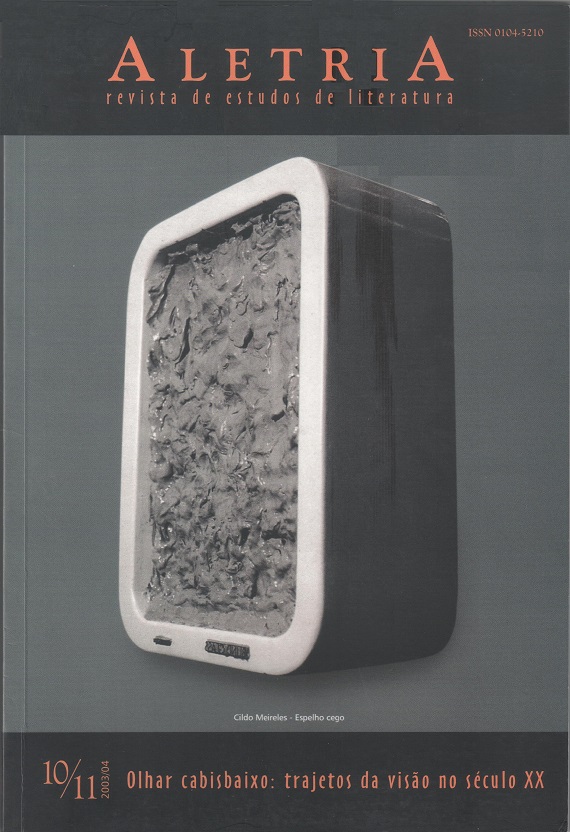Morte da imagem e eterno retorno do nonsense
DOI:
https://doi.org/10.17851/2317-2096.10..30-52Keywords:
visão, abjeção, alegoria, vision, abject, allegory.Abstract
Resumo: O fantasma está ligado não só a uma experiência íntima ao sujeito mas também a algo radicalmente alheio a ele, cuja saturada proximidade produz uma ausência paradoxal de sentido. O nonsense ou angústia do sujeito desvenda-nos a passagem entgre o corpo material e a lei paterna, mas exibe,ainda, a fragilidade de nossos próprios limites (dentro/fora). O debate dessas questões, em artistas como Marcel Duchamp ou teóricos como Carl Einstein, é o objetivo deste ensaio.
Palavras-chave: visão; abjeção; alegoria.
Abstract: There is a fantasmatic substance not only intimate with the subjet but also radically alien to it whose overproximity produces a paradoxical lack of sense. This nonsense or panic in the subject shows the passage between the material body and the paternal law as well as the fragility of our boundaries (inside/ outside). The discussion of these topics in such artists as Marcel Duchamp or theorists like Carl Einstein is the focus of this paper.
Keywords: vision; abject; allegory.
Downloads
References
AGAMBEN, Giorgio. A zona morta da lei. Folha de S. Paulo, 16 mar. 2003. Mais! p.4-8.
AGAMBEN, Giorgio. Bataille e il paradosso della sovranita. In: RISSET, Jacqueline (ed.) Georges Bataille: il político e il saem. [s.l.]: Liguori Editore, 1987. p. 115,119.
AGAMBEN, Giorgio. The Messiah and the Sovereign: The Problem of Law in Walter Benjamin. In: ______. Potentialities. Edited and translated by Daniel Heller,Roazen. Stanford: Stanford University Press, 2000.(Collected Essays in Philosophy)
ANDRADE, Mário de. Macunaíma. Ed. crítica Telê Ancona Lopez. Paris: Archivos, 1988.
ANTELO, Raul. El inconsciente óptico dei modernismo. In: SOSNOVSKI, Saul. La cultura de un siglo. América Latina en sus revistas. Buenos Aires: Altanza, 1999. p. 297-310.
BATAILLE, Georges. A propos de Pour qui sonne le glass de E. Hemingway. Actualité, v. 1, 1945.
BATAILLE, Georges. Oeuvres Completes. Paris: Gallimard, 1971.
BOURGEOIS, Louise. Destruction of the Father, Reconstruccion of the father. lntcrviews 1923,1997. Ed. M. L. Barnadac e H. U. Obrist. Cambridge: MIT Press, 1998.
BUCK-MORSS, Susan. Dreamworld and catastrophe. The passing of Mass Utopia in East and West. Cambridge: MIT Press, 2000.
BUCK-MORSS, Susan. Aesthetics and anaesthcrics. Walter Benjamin's Artwork Essay Reconsidered. October, n. 62, outono 1992.
CHÉNIEUX-GENDRON, Jacqueline. L'envers du monde, l'envers de la langue: un "travail" surréaliste. In: La Révolutiion Surréaliste. Paris: Centre Pompidou, 2002. p. 349-359.
DELEUZE, Gtllcs. Nietzsche et la Philosophie. Paris: PUF, 1962.
DERRIDA, Jacques. The law of genre. In: Acts of Literature. Ed. Derek Atrridge. New York: Routledge, 1992. p. 221-252.
DERRIDA, Jacques. Moscou aller-retour. Paris: L'Aube, 1995.
DIDI-HUBERMAN, Georges. Ce qui nous voyons, ce qui nous regarde. Paris: Mtnuit, 1992.
DIDI-HUBERMAN, Georges. La ressemblence informe, ou le gay savoir visuel selon Georges Bataille. Paris: Macula, 1995.
DIDI-HUBERMAN, Georges. L'image survivante. Histoire de l'art et temps des fantômes selon Aby Warburg. Paris: Minuit, 2002.
DREIER, Katherine; MATTA ECHAURREN. Duchamp's glass. La mariée mise à nu par ses célibataires, même. New York: Societé Anonyme, 1944.
DUCHAMP, Marcel. Notes. Paris: Flammarion.
EINSTEIN, Carl. Negerplastik. In: Qu'est-ce que la sculpture moderne?Paris: Centre Georges Pompidou, 1986. p.344-353.
LEVI-Strauss, Claude. Introdução à obra de Marcel Mauss. In: Sociologia e Antropologia. São Paulo: EPU; EDUSP, 1974. p. 1-37.
MEDEIROS, Sérgio (ed.). Makunaíma e Jurupari. Cosmogonias ameríndias. São Paulo: Perspectiva, 2002.
METRAUX, Alfred. La religion des Tupinamba. Paris: 1928.
NANCY, Jean-Luc. Une pensée finie. Paris: Galilée, 1990.
ROUGEMONT, Denis de. Marcel Duchamp mine de rien. Preuves, Paris,
a. 18, n. 204, fev. 1968.
Downloads
Published
How to Cite
Issue
Section
License
Copyright (c) 2003 Raul Antelo (Autor)

This work is licensed under a Creative Commons Attribution 4.0 International License.
Authors who publish with this journal agree to the following terms:Authors retain copyright and grant the journal right of first publication with the work simultaneously licensed under a Creative Commons Attribution Non-Commercial No Derivatives License that allows others to share the work with an acknowledgement of the work's authorship and initial publication in this journal.Authors are able to enter into separate, additional contractual arrangements for the non-exclusive distribution of the journal's published version of the work (e.g., post it to an institutional repository or publish it in a book), with an acknowledgement of its initial publication in this journal.Authors are permitted and encouraged to post their work online (e.g., in institutional repositories or on their website) prior to and during the submission process, as it can lead to productive exchanges, as well as earlier and greater citation of published work (See The Effect of Open Access).





